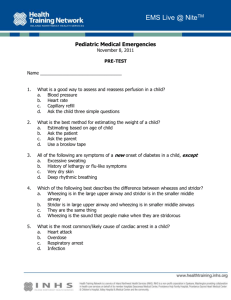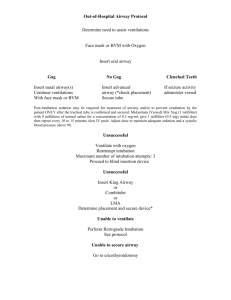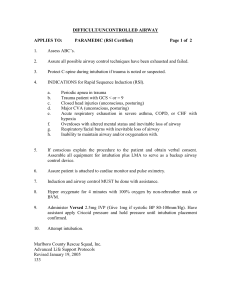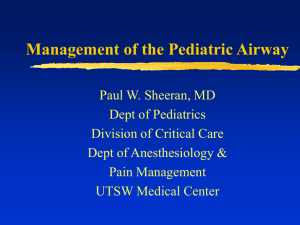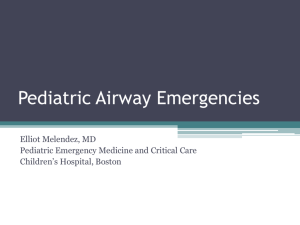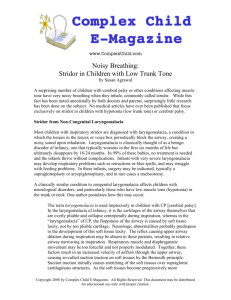Croup and Airway Management - Wellington Intensive Care Unit
advertisement
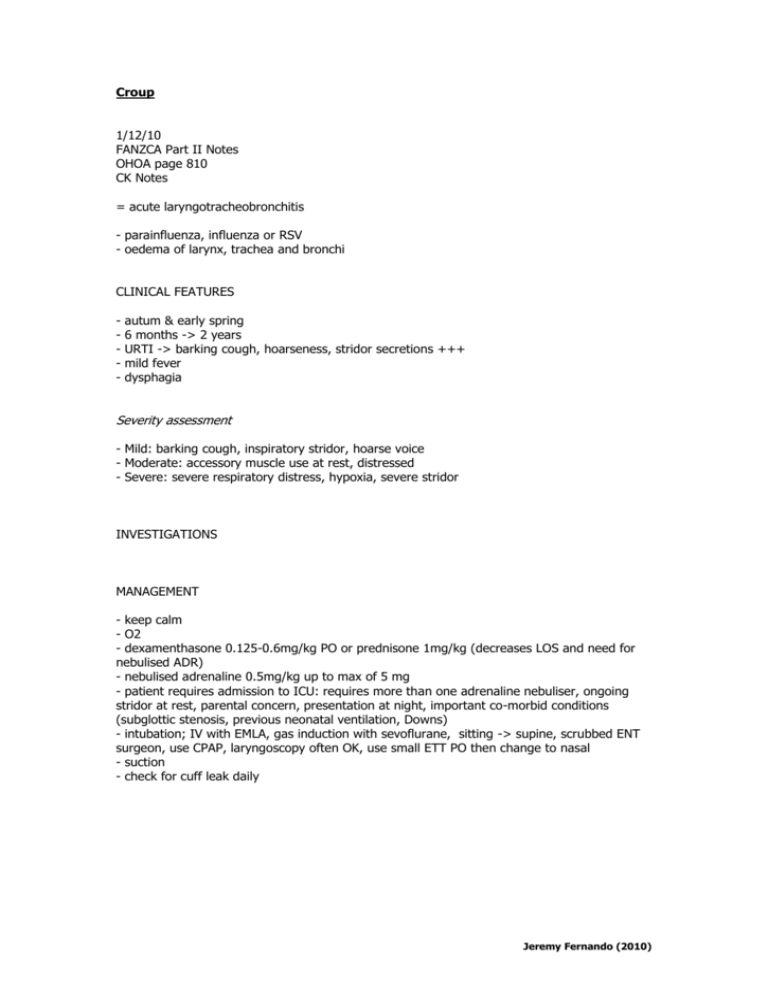
Croup 1/12/10 FANZCA Part II Notes OHOA page 810 CK Notes = acute laryngotracheobronchitis - parainfluenza, influenza or RSV - oedema of larynx, trachea and bronchi CLINICAL FEATURES - autum & early spring 6 months -> 2 years URTI -> barking cough, hoarseness, stridor secretions +++ mild fever dysphagia Severity assessment - Mild: barking cough, inspiratory stridor, hoarse voice - Moderate: accessory muscle use at rest, distressed - Severe: severe respiratory distress, hypoxia, severe stridor INVESTIGATIONS MANAGEMENT - keep calm - O2 - dexamenthasone 0.125-0.6mg/kg PO or prednisone 1mg/kg (decreases LOS and need for nebulised ADR) - nebulised adrenaline 0.5mg/kg up to max of 5 mg - patient requires admission to ICU: requires more than one adrenaline nebuliser, ongoing stridor at rest, parental concern, presentation at night, important co-morbid conditions (subglottic stenosis, previous neonatal ventilation, Downs) - intubation; IV with EMLA, gas induction with sevoflurane, sitting -> supine, scrubbed ENT surgeon, use CPAP, laryngoscopy often OK, use small ETT PO then change to nasal - suction - check for cuff leak daily Jeremy Fernando (2010) AIRWAY MANAGEMENT Indications for Intubation in a child with croup Failure of medical treatment (O2, nebulised adrenaline, dexamethasone) and progression to: - exhaustion from increased work of breathing hypercapnic respiratory failure hypoxic respiratory failure (child would usually be obtunded) decreased LOC (and not protecting own airway, responding to pain only) imminent airway obstruction Upper Airway Obstruction (COMET-Failure) Call for help Optimise treatment Monitoring Equipment and Drugs Technique Failure – plan for failed intubation Call for help - another anaesthetist to be present - an ENT surgeon scrubbed and ready to perform emergency tracheostomy Optimise Medical Treatment - high flow O2 (avoid distressing child – hold mask away, keep on parents lap if appropriate) - nebulised adrenaline 5mg (repeated doses) - dexamethasone 0.6mg/kg IV Jeremy Fernando (2010) - oxygen/helium mixture - obtain IV access (using EMLA and parents comforting patient) – if this will distress the child too much then delay until under anaesthesia Monitoring - P SpO2 NIBP ETCO2 end-tidal anaesthetic agent concentration Equipment - range of ET tube sizes 4.0/4.5/5.0 two laryngoscopes with a range of blades small bougie cannulae for needle cricothyroidotomy + method of O2 delivery suction Technique (1) inhalational induction (preferred) (2) IV induction with paralysis Inhalational Induction Patient will have critical laryngeal oedema and airway obstruction below the level of the vocal cords. If patient is still breathing and is able to be transferred to theatre, the safest way to induce this patient will be using an inhalational induction with maintenance of spontaneous ventilation until airway is secure. - slowly turn up sevoflurane concentration to 8% mixed with O2 - wait until adequate depth of anaesthesia (eyes are mid line and small) - gentle laryngoscopy with assessment of laryngeal inlet - intubation with a small uncuffed endotracheal tube (probably size 4.0 to 4.5) -> preferably using a nasal tube as this patient will need to be transferred to a paediatric intensive care unit and nasal tube provides easier fixation and are easier to care for. IV Induction with Paralysis - if patient obtunded and needs emergency intubation then a rapid sequence induction with cricoid pressure may be used. - an LMA or fiberoptic bronchoscope are unlikely to be helpful Failure - LMA facemask needle cricothyroidomy surgical cricothyroidomy Jeremy Fernando (2010)
